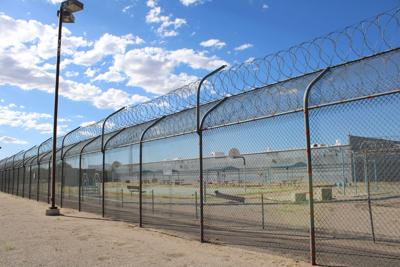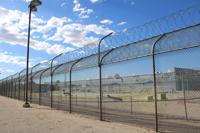
Exterior fence of the now-shuttered Arizona State Prison-Marana in the Town of Marana, Arizona. (Isabela Gamez/CALÓ News)
Corrections: A previous version of this story misidentified Liliana Soto, the press secretary for Gov. Katie Hobbs' office.
Tucson, Ariz. – On the outskirts of Marana, Arizona, the cold walls of a decommissioned prison now lie in the hands of a private prison company with a controversial track record, concerning community members and immigration advocacy groups about the role the facility will play in advancing the Trump administration’s mass deportation agenda in the state.
Management and Training Corporation (MTC), which operates detention and correctional facilities nationwide, quietly acquired the Marana site in July 2025 from the Arizona Department of Administration. MTC was the previous owner before the state obtained it in 2013.
While neither the company nor federal immigration officials have confirmed future plans for the site, activists and residents are closely watching, worried that it could soon be converted into another immigration detention center.
The state already is home to five detention facilities: the Central Arizona Florence Correctional Center, the Eloy Detention Center, the San Luis Regional Detention Center and two facilities at the Florence Service Processing Center, which are split into a main holding facility and a short-term “staging” facility meant to hold detainees for a maximum of 72 hours.
In September, ICE held nearly 60,000 people in detention nationwide, according to agency data published online. This figure, approaching an all-time high, represents a dramatic increase by almost 50% from the roughly 39,000 people in custody in December 2024, the final full month of the Biden administration.
Approximately 2,690 individuals were held in civil detention in Arizona's facilities, based on aggregate data released by ICE on Sept. 25. Nearly 70% of those people detained have no criminal convictions, reflecting a national trend towards prioritizing all undocumented people for deportation under the Trump administration, despite campaign promises by several now-Trump administration officials of solely going after the “worst of the worst.”
The surge in the detained population has placed a significant strain on ICE’s network of facilities. A report published in July by the Transactional Records Access Clearinghouse (TRAC) at Syracuse University analyzed the number of people detained in mid-April and found that nearly a quarter of facilities (45 of 181) exceeded their "contractual capacity" — the number of detention beds required under contract.
While ICE’s overall contractual capacity in Arizona remains unclear because this information is typically not disclosed in public documents like detention oversight documents, TRAC’s report provided figures for two facilities — obtained through a recent Freedom of Information Act (FOIA) campaign — including the Central Arizona Florence Correctional Center, which has 400 beds, and the San Luis Regional Detention Center, with 150 beds.
This brings ICE’s capacity in the state to a currently known total of just over 2,000 detention beds, with Eloy Detention Center contributing another 1,500 beds, according to a 2018 report by Homeland Security’s Office of Inspector General. Bed capacity at the Florence Service Processing Center was not immediately available.
Ricardo Reyes, executive director of the progressive veterans group Vets Forward, said the sale raises alarms among groups advancing immigration justice.
“We’re concerned about the treatment at all the detention centers because all of the stories we’ve been hearing say that the treatment of the detainees has not been good,” Reyes said. “We need oversight. We also need states to make sure they pass laws that will protect the detainees because the majority of them have never committed any crime. Many of them crossed the border with a visa and either overstayed or were here with legal status.”
Aurora Ramirez, an organizer with the Party for Socialism and Liberation (PSL) in Tucson, said her group was “shocked but not surprised” at the possibility of a detention center in Marana, citing the state’s political climate — including the passing of the 2010 Senate Bill 1070, known as the “show me your papers” law, which was partially struck down in 2012, and the 2024 Proposition 314, which created new state-level immigration crimes and has yet to be enforced.
“Just in general, we oppose mass incarceration. We especially oppose private corporations profiting from incarceration, which is what this would be,” Ramirez said.
Arizona could become home to sixth MTC immigration detention facility
The recent sale of the former Marana Community Correctional Treatment Facility expands the reach of the third-largest private correctional operator in the United States, effectively clearing the way for MTC to establish its sixth federal detention center and increase its immigration detention capacity.
The sale of the vacant state prison — shuttered by Gov. Katie Hobbs in 2023 — comes as the federal government has begun utilizing part of the $45 billion congressional funding to expand detention facilities over the next four years, signing contracts in California and Texas to reopen former prisons.
Shortly after President Donald Trump’s second term in the White House began, MTC hired Upstream Consulting, Inc., a D.C. lobbying firm, to advocate for “Funding for ICE detention beds.”
In May, an "indefinite delivery/indefinite quantity" contract between MTC and ICE was finalized, giving the agency the flexibility to order an unspecified amount of detention services as needed through May 2027.
Vic Hathaway, communications manager for the Town of Marana, said in a statement to CALÓ News that the town was informed “a few months ago” the facility might be used as an ICE detention center, but has not received official confirmation.
In an email to CALÓ News, MTC stated that no contracts have been signed and that the company has not yet determined how the Marana facility will be utilized. “While there has been speculation about it being used for ICE, no final decisions have been made,” Emily Lawhead, MTC’s director of communications, wrote.
The Arizona Department of Administration, which handled the sale of the property, told CALÓ News that the Arizona Department of Corrections was not involved and that the state did not place any restrictions on how MTC may use the facility.
Gov. Hobbs has explicitly made promises that her office will not assist the federal government in carrying out Trump’s mass deportation plan. Liliana Soto, press secretary for the Office of the Arizona Governor, told CALÓ News that the $15 million sale of the Marana prison to MTC was strictly a strategic financial move and not related to the current administration.
"The Marana prison contract ended on Dec. 31, 2023, and the marketing and sale process was initiated prior to Donald Trump winning the election and taking office," Soto said. "There were three bidders for the facility, and the state sold it to the highest bidder. It had nothing to do with the results of the presidential election."
Soto defended the sale as a fiscally responsible move.
"The administration had a choice: either keep wasting taxpayer dollars maintaining a building the state wasn't using, or sell it for money that can be used to expand access to affordable child care, invest in public education and fight veteran homelessness," she stated.
Soto distanced the Governor's Office from any potential use of the facility for immigration purposes, stating, "The Governor’s Office is not in contact with the federal government about immigration detention facilities and will not partner with the federal government on immigration detention.”
Although state and MTC officials have not given a definitive answer, an internal planning document obtained by the Washington Post highlights the Marana facility, among others, as a focus for immigration authorities.
Federal immigration officials intend to increase the nationwide holding capacity to approximately 107,000 detention beds, doubling the capacity previously funded by Congress, according to The Post’s reporting. Arizona’s capacity to hold people in ICE detention would nearly double, according to The Post’s reporting, with the Marana facility projected to add 500 additional beds.
Tricia McLaughlin, a spokeswoman for the Department of Homeland Security, confirmed to The Post via email that ICE created the planning document. However, she added that the list, last updated on July 30 as per The Post, was outdated and had not received approval. McLaughlin stated that the listed contracts “are not accurate” but chose not to provide further details.
ICE officials did not respond to a request for comment.
MTC track record shows medical neglect, poor conditions
MTC currently oversees the Imperial Regional Detention Facility in California, the Otero County Processing Center in New Mexico and the Bluebonnet Detention Facility, El Valle Detention Facility and IAH Polk Adult Detention Facility in Texas.
Additionally, the Utah-based private prison company operates ten correctional facilities across the U.S.
ICE’s public detention data indicates that between Sept. 2 and Sept. 15, MTC’s five facilities held nearly 4,500 people on average each day.
TRAC’s July report revealed that two MTC facilities — the Imperial Regional Detention Facility with a capacity of 704 beds and the Bluebonnet Detention Facility with 1,000 beds — were operating beyond their contractual capacity in mid-April. The Bluebonnet facility was over capacity by more than 200 individuals.
Over the years, the company has faced criticism for staffing shortfalls, medical neglect and poor facility conditions.
In 2024, the Texas Commission on Jail Standards issued a notice of non-compliance for MTC’s Giles W. Dalby Correctional Facility, citing missed prisoner checks and insufficient safety training.
In Mississippi, an audit found the company had failed to meet staffing requirements at its facilities, ultimately returning over $5 million to the state.
Unannounced inspections of MTC detention facilities conducted by ICE's Office of Detention Oversight between November 2024 and March 2025 reveal a mixed record of operational compliance.
Two facilities, the Otero County Processing Center in New Mexico and the Bluebonnet Detention Facility in Texas, earned "Superior" ratings, with Otero County dramatically reducing its deficiencies from six in the prior year to just one.
However, a report issued in September of this year by the U.S. Commission on Civil Rights’ New Mexico Advisory Committee, a nine-member panel, recommended the closure of the Otero County Processing Center and three other detention facilities in the state, citing concerns about the alleged mistreatment of detainees and unsafe conditions.
The sharp critique comes a year after the death of Jhon Benavides Quintana, a 32-year-old Ecuadorian man, who died on June 15, 2024 after reporting medical issues three weeks prior. The American Civil Liberties Union (ACLU) of New Mexico, in a release, stated the death shows MTC and ICE are "unwilling and unable to detain asylum seekers… in a safe and humane way."
Two other Texas facilities operated by MTC showed recurring problems. The El Valle Detention Facility was cited for three deficiencies related to detainee property and monitoring.
The IAH Secure Adult Detention Facility saw its compliance trend downward, with inspectors finding five deficiencies — a significant increase from one the previous year. Most notably, the facility was cited for a repeat deficiency in its suicide prevention monitoring, a priority component of detention standards.
Safety concerns mount for Marana and Arizona residents
For Marana residents, the prison’s possible reopening has prompted worries about jobs, safety and the town’s future.
Belinda Stevens, a former advisor at Marana High School and current Marana homeowner, said the facility could have a chilling effect on families and students in the area.
“My concerns as a former employee of Marana School District are that it could lead to students feeling fearful. Also, it might drive some families out of the area and [people of color] may not feel safe living there anymore,” Stevens said. “I am not in support of this. I am still a homeowner in Marana and it would be sad to see the town go backwards because people of color or people who lean a certain way politically don’t feel comfortable there.”
Desiree Auge, a Tucson resident studying Criminology and Social Justice at Arizona State University, has been closely following the facility's developments.
“If the Marana prison were to open as an ICE detention center, it would encourage [immigration authorities] to arrest anybody that they could and focus more on racial profiling than actually arresting people that were previously charged with violent crimes,” she said.
Organizers, like Ramirez, however, are already mobilizing. A discussion on the Marana prison is scheduled to take place at Coyote Trails Elementary School in Tucson on October 23 at 6:30 p.m. The panelists include representatives from the ACLU of Arizona, the Florence Immigrant and Refugee Rights Project, which provides free legal services to immigrants facing deportation, and Just Communities Arizona, an abolitionist organization that advocates for ending mass incarceration across the state.
She added that PSL’s recently launched “Stop the Kidnappings” campaign could also take on the issue if the site moves forward.
Arizona’s detention facilities have sparked concern due to reports of deaths in custody, medical neglect and unsafe living conditions.
In 2025, several deaths were reported in Arizona detention facilities, including Dupree Rollins at La Palma Correctional Center in March, Jose Calvillo at the same facility in July and Lorenzo Antonio Batres Vargas at the Central Arizona Correctional Complex in August.
“These facilities are often refurnished quickly to serve as detention centers, but they are not adequate to hold many people and are very overcrowded,” Reyes said.
In an article by Phoenix New Times, Noah Schramm, an immigration and border policy strategist with the ACLU of Arizona, said he is “absolutely concerned about the very likely scenario that this facility will become an ICE detention center.”
“From our experience with detention centers in Arizona … there are real concerns about conditions and access to basic rights and medical care,” he said, adding that the ACLU continues to monitor potential immigration detention plans for the Marana facility.
Raphael Romero Ruiz is a journalist and a graduate fellow at the Howard Center for Investigative Journalism and now lives in Baltimore. Born and raised on the southside of Tucson, Arizona, he formerly covered the border beat for The Arizona Republic, reporting on immigration issues and communities across the Arizona-Mexico borderlands.
Isabela Gamez is a Tucson-based journalist and graduate of the University of Arizona’s School of Journalism. She served as the UA School of Journalism’s Don Bolles Fellow and previously interned at Voice of America, The Arizona Mirror and Arizona Public Media. Her work has appeared in Tucson Spotlight, Tucson Foodie and other publications. She reports on social justice issues and feature stories across the Southwest.









(0) comments
Welcome to the discussion.
Log In
Keep it Clean. Please avoid obscene, vulgar, lewd, racist or sexually-oriented language.
PLEASE TURN OFF YOUR CAPS LOCK.
Don't Threaten. Threats of harming another person will not be tolerated.
Be Truthful. Don't knowingly lie about anyone or anything.
Be Nice. No racism, sexism or any sort of -ism that is degrading to another person.
Be Proactive. Use the 'Report' link on each comment to let us know of abusive posts.
Share with Us. We'd love to hear eyewitness accounts, the history behind an article.